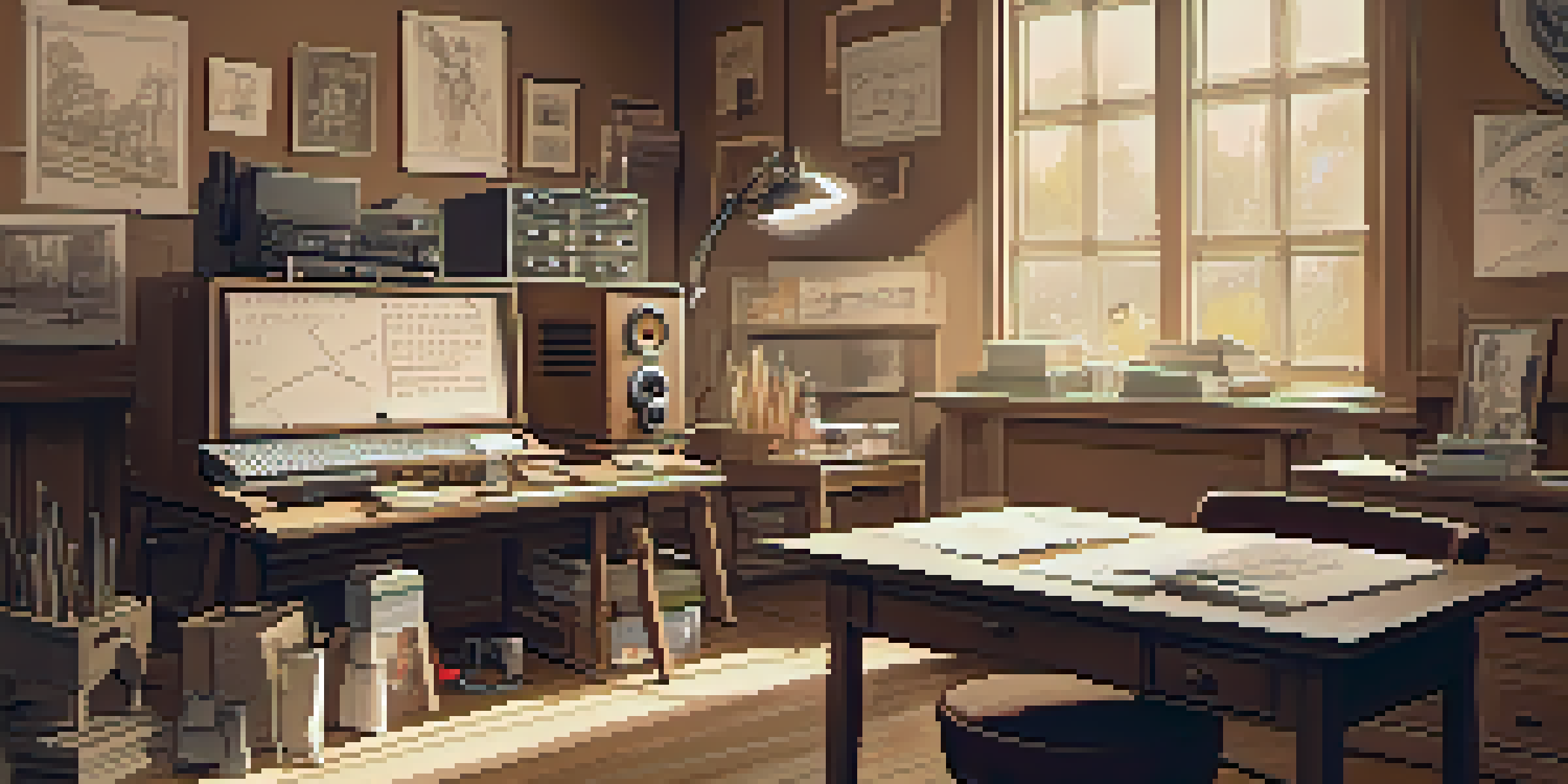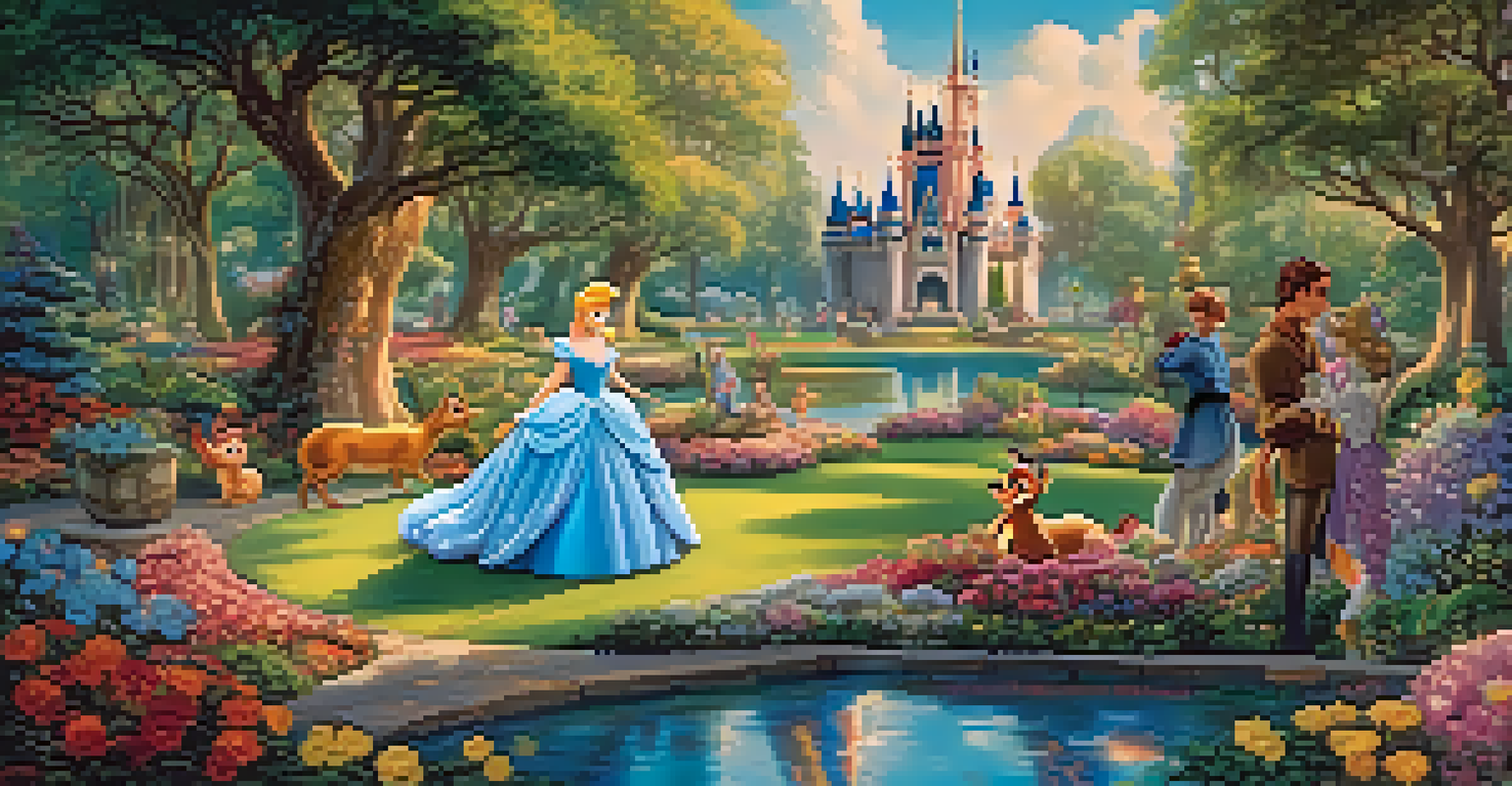Animation in Film: From Early Disney to Modern Masterpieces

The Birth of Animation: Early Beginnings in Film
Animation has roots that stretch back to the late 19th century, with early inventors like Emile Cohl creating simple animated sequences. These pioneering works laid the groundwork for what would eventually become a beloved art form. The magic of animation captivated audiences and inspired countless artists to explore this new medium.
Animation can explain whatever the mind of man can conceive.
As technology advanced, so did the complexity of animated films. By the 1920s, studios began experimenting with synchronized sound and color, making animated shorts more engaging. This period marked the transition from simple flips and frames to a more storytelling approach, allowing animators to showcase their creativity.
The arrival of Walt Disney in the 1930s represented a significant turning point. Disney's innovative techniques, such as the use of multi-plane cameras, added depth and dimension to animation. This era birthed iconic characters and stories that still resonate today, like 'Steamboat Willie' and 'Snow White and the Seven Dwarfs.'
Disney's Golden Age: Icons and Innovations
The Golden Age of Disney, spanning from the 1930s to the 1960s, produced some of the most memorable animated films in history. Classics like 'Pinocchio,' 'Bambi,' and 'Cinderella' showcased Disney’s ability to blend storytelling with stunning visuals. These films not only entertained children but also resonated deeply with adults, creating a shared cultural experience.

During this time, Disney focused on character development and emotional storytelling, elevating animation to new heights. Each character, from the brave Bambi to the enchanting Cinderella, was crafted with depth and personality, making them relatable to audiences of all ages. This approach set a benchmark for storytelling in animation.
Animation's Evolution Over Time
Animation has transformed from simple 19th-century sequences to complex storytelling that captivates audiences of all ages.
Moreover, Disney's commitment to innovation pushed the boundaries of animation technology. The introduction of Technicolor and improved animation techniques brought vibrant worlds to life. This dedication to quality ensured that Disney films remained timeless treasures, loved by generations.
The Rise of Television Animation: New Opportunities
As television became more popular in the 1960s and 70s, animation found a new platform to flourish. Shows like 'The Flintstones' and 'Scooby-Doo' brought animated characters into living rooms across America. This shift allowed for a different kind of storytelling, often infused with humor and social commentary.
The art of animation is the art of life itself.
Television animation opened doors for creativity and experimentation. New genres emerged, such as educational cartoons for children and satirical shows for adults. This diversification helped animation reach broader audiences and solidified its place in popular culture.
However, the transition to TV also led to a change in production values. Many animated series operated on tighter budgets and schedules, which sometimes affected animation quality. Despite this, the charm and wit of these shows captured the hearts of viewers and paved the way for future generations of animators.
The Renaissance of Animation: 1990s Resurgence
The 1990s marked a renaissance for animation, particularly for Disney, which returned to its roots of storytelling and artistry. Movies like 'The Lion King,' 'Beauty and the Beast,' and 'Aladdin' showcased a blend of captivating narratives and stunning hand-drawn animation. This era reignited the public's love for animated films and brought them back into the spotlight.
During this time, Disney not only revived its legacy but also embraced technological advancements. The incorporation of computer-generated imagery (CGI) began to enhance traditional animation techniques, offering new possibilities for creativity. This fusion of styles helped create visually stunning films that captivated audiences around the world.
Disney's Impact on Animation Culture
Disney's innovative techniques and memorable characters during its Golden Age set a benchmark for emotional storytelling in animation.
The success of animated films in the 90s also led to the emergence of new competitors. Studios like Pixar began to challenge the status quo, producing groundbreaking films like 'Toy Story,' the first entirely CGI feature film. This shift in animation technology and storytelling dynamics opened doors for an entire new wave of animated storytelling.
The Impact of CGI: Transforming Animation Forever
The introduction of CGI in the late 1990s and early 2000s revolutionized the animation industry. With the ability to create lifelike characters and immersive worlds, CGI opened up a realm of possibilities that traditional animation couldn't achieve. This shift not only changed how stories were told but also how audiences experienced them.
Films like 'Shrek' and 'Finding Nemo' showcased the potential of CGI, combining humor with stunning visual effects. These films also reflected a shift in storytelling, focusing on themes of friendship, acceptance, and adventure. The characters felt more relatable, and the animation itself became a character in its own right.
As CGI technology advanced, it became a staple in not just animated films, but also live-action movies. This blending of animation with live-action created unique cinematic experiences, appealing to a wider audience. The impact of CGI continues to influence both animated and non-animated films today, expanding the horizons of storytelling.
Animation Beyond Disney: Independent Films and Global Influence
While Disney remains a major player in the animation industry, the landscape has diversified significantly. Independent animators and global studios have emerged, bringing fresh perspectives and styles to the medium. Films like 'Spirited Away' by Studio Ghibli and 'The Secret of Kells' showcase the rich storytelling traditions from around the world.
This global influence has enriched animation, allowing for a variety of artistic expressions. Different cultures and storytelling techniques have found their way into animated films, creating a vibrant tapestry of narratives. Viewers are now treated to a plethora of styles and stories that resonate across cultural boundaries.
The Rise of Independent Animation
The emergence of independent studios and global influences has diversified animation, enriching its narratives and styles.
Moreover, the rise of streaming platforms has given independent and international films a platform to shine. Audiences have greater access to diverse animated content, leading to a renaissance of storytelling that goes beyond mainstream offerings. This shift encourages innovation and creativity, ensuring the evolution of animation continues.
The Future of Animation: Trends and Innovations
Looking ahead, the future of animation is bright, with technology continually evolving. Virtual reality (VR) and augmented reality (AR) are beginning to play significant roles in storytelling, offering immersive experiences that engage viewers in new ways. These advancements are pushing the boundaries of traditional animation and opening doors to exciting possibilities.
Additionally, there is a growing emphasis on inclusivity and representation in animated storytelling. Creators are recognizing the importance of diverse voices and perspectives, leading to richer narratives that reflect the world we live in. This shift is fostering a new generation of animators who bring their unique experiences to the forefront.

As audiences become more discerning, the demand for quality storytelling remains paramount. Whether through traditional hand-drawn techniques or cutting-edge CGI, the essence of animation lies in its ability to connect and inspire. The future of animation promises to be an exciting journey, filled with innovation and creativity.